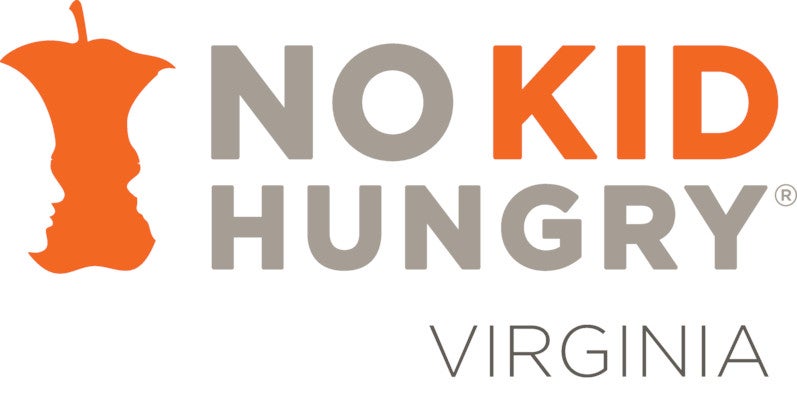One year after Virginia schools first pivoted to virtual learning, school leaders from across the state joined No Kid Hungry Virginia for a townhall to discuss how school divisions mobilized meal programs overnight to serve students and families during the pandemic.
Sarah Steely, No Kid Hungry Virginia Associate Director, moderated the panel between Chip Jones, Superintendent of Cumberland County Schools; Dr. Clint Mitchell, principal at Mount Vernon Woods Elementary School in Fairfax County; and Larry Wade, School Nutrition Director at Chesapeake Public Schools.
You may also access the video recording here.
Here are five takeaways from the event:
1) The pandemic increased food insecurity in rural and urban communities. School nutrition teams played a critical role in nourishing families.
As many as one in five children in the commonwealth could face hunger this year, up from one in eight prior to the pandemic.
When schools pivoted to virtual instruction in response to the COVID-19 pandemic on March 16, 2020, all of Virginia’s 132 public school divisions mobilized to ensure that students stayed nourished, no matter where they were learning.
Jones described the significant impact COVID-19 had on rural Cumberland County over the last year and how school nutrition teams worked together to serve students safely and efficiently.
“At the beginning of the pandemic, we knew that the issue of hunger was our top priority,” said Jones. “Over the past year, we’ve seen the importance of school meals not only to our students but to the surrounding community.”
Jones applauded his team for their speed, resiliency and dedication to finding innovative, accessible ways to feed students and their families throughout the pandemic.
“School nutrition workers are usually some of the lowest-paid members of our community, but they are always ready and willing to take on the biggest challenges,” added Jones.
2) Nutrition teams innovated to remove access barriers and reach more kids, while working to ensure families and staff were kept safe.
Meal sites offered a variety of distribution models to help safely connect students with meals and promote social distancing, including “Grab and Go” service and food delivery along bus routes while passing out multiple days’ worth of meals at one-time.
School leaders in Chesapeake created “SNN,” or “School Nutrition News,” a flyer and letter program to increase word of mouth about meal distributions.
“Chesapeake embraced an ‘all hands on deck’ kind of mentality from the superintendent to the school board, principals, and nutrition staff to rally around the efforts, to make sure that our students received nutritious meals with the virtual concept in place,” added Wade.
3) Nutrition teams continue to go above and beyond to connect students with meals.
All participants praised local school nutrition professionals for their hard work and compassion throughout the pandemic.
“Nutrition teams are superheroes,” said Mitchell. They never complained about coming to work. They didn’t say, ‘we can’t do it.’ They found a way to do it.”
“What started as a simple curbside service has grown into a program that serves breakfast, lunch, dinner, and snacks to all 45 of our schools on Tuesdays and Thursdays. To say that our teams are superheroes would be an understatement,” said Wade.
4) School meals are a critical tool to advance racial equity.
Food insecurity is increasing at startling rates. Data from No Kid Hungry indicates that almost half of American families are living with hunger during the pandemic. Food shortages are even worse in Black and brown communities: 53% of African-American families and 56% of Latino families are experiencing hunger.
“Students of color are disproportionately impacted by the hunger crisis. When it comes to equity, we must focus not only on school meals, but on transportation and public health issues as well,” said Principal Mitchell.
Mitchell explained how the Fairfax school nutrition team incorporated deliveries and started distributing meals on the weekends to reach parents: “Many parents are essential workers and aren’t able to pick up food during the week. By extending school meals into the weekend, we are serving more families in the community.”
“It’s all about access. Equity is about making sure we provide our students with exactly what they need when they need it,” added Mitchell.
5) Federal waivers have made a huge impact.
As the state reopens for in-person learning and after the pandemic, meal programs will continue to be a critical tool to address hunger in Virginia’s communities.
The USDA recently extended child nutrition waivers — originally implemented last year — through September 30. As schools and community organizations continue to reimagine traditional meal programs during this ongoing crisis, these waivers will extend critical flexibilities to keep reaching kids with the nutrition they need. For example, these waivers make it possible for schools and organizations to package multiple meals for parents to pick up for the week, or for meals to be dropped off at a child’s home. In turn, they also help hard-working school nutrition staff plan effectively and provide certainty to the families who interact with these meal programs, while providing additional stability to the supply chain that is an essential part of local economies.
“The USDA and legislators acknowledged the need to provide healthy and nutritious meals to all the children of America [through the waivers] as a result of the pandemic, said Wade. “The waivers and flexibilities that have been offered, have opened the opportunity to see our program through a different lens and perspective. By allowing students to receive meals regardless of their economic status, it’s allowed our communities to come together to support a need that’s always been there.”
“I think it will provide our legislators and communities a great opportunity to come together and fight the issue of hunger as a united front,” added Wade. “Because at the end of the day, you can’t teach a hungry child.”






